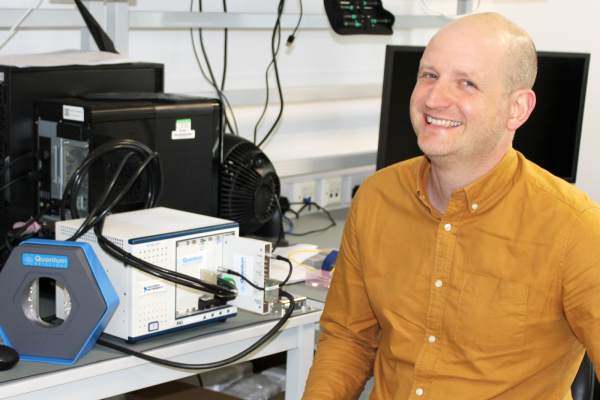ESTEEM3 interviews: Liam O’Ryan from Quantum Detectors (QD)

Liam O’Ryan is the Head of Research and Development at Quantum Detectors (QD), a leading company that has a proven track record in undertaking all aspects of the commercialisation process and has specific experience in the field of electron microscopy. Let's find out more about him!
In this interview, Liam O’Ryan will explain his background, his role, and his views about ESTEEM3.
QUESTION: Tell us a bit about yourself and your background…
I’m Liam O’Ryan, I’m the Head of Research and Development at Quantum Detectors (QD). My background is in Structural Biology, I have a degree in Bioinformatics and a Ph.D. in Structural Biology from the University of Manchester.
After working for some time in academic research, I took the opportunity to join Quantum Detectors around 8 years ago. At the time, Quantum Detectors was a very small spinout from Diamond Light Source and Science and Technology Facilities Council – STFC which both are UK research facilities. We began to develop and commercialise cutting edge detector technology from our parent organisations. As we grew the company, our products became more successful, and we were able to address different sectors.
Quantum Detectors is now around 35 people and enjoys a strong position in synchrotron science and transmission electron microscopy, with hundreds of products installed all over the world.
QUESTION: Why did you decide to take part in the ESTEEM3 project?
We were already working with NanoMEGAS and with the University of Oxford, both of whom had been part of previous ESTEEM projects. They had told us that the ESTEEM projects were an exciting place to be, so we were delighted to be invited to participate in ESTEEM3. The opportunity to work with the leading laboratories in Europe to further methodology development in TEM and improve detector technology to accelerate scientific discovery was too good to miss! These opportunities don’t come around very often, and we were much smaller than we are now as well, so it was nice to be invited and we were pleased to accept.
QUESTION: What is your role in ESTEEM3?
In ESTEEM3, Quantum Detectors is focused on improving methodology and advancing the art in detector technology for imaging and diffraction applications, - that’s the main area. During the course of this project, we have worked closely with partners on ESTEEM3 to develop an application-aware user interface for 4D STEM, we’ve tested novel sensor materials and we’ve increased the speed of our Merlin EM detectors. Working this closely with our ESTEEM3 partners has helped drive our detector development forward to meet the needs of the Electron Microscopy community.
QUESTION: You have a special place in the ESTEEM3 consortium because you are a part of the industrial partners of the project. What do you think the project brings to the European industry? How does it support European science in the area?
ESTEEM3 provides an opportunity for industry and academic partners on the project to freely exchange ideas in a collegiate and collaborative environment. Whilst Quantum Detectors has been focussed on imaging and diffraction work packages, the structure of the project allows us to work across work packages too with other members.
Although we weren’t funded by ESTEEM3 to undertake this work, we’ve been pleased to contribute to the open source LiberTEM software project driven by Jülich and to develop EELS detector systems with the CNRS-LPS laboratory, both of which came about due simply to being in the same room as Europe’s finest electron microscopists.
The obvious benefit to the European scientific instrumentation industry is the shortening of development time on new technologies. We have been able to really make a difference just by being in the same room as the people who were driving the experiments forward. More broadly, Industry in Europe will benefit from the new technologies and experimental techniques developed by ESTEEM3. There have been some advances here and when the project ends, those advances don’t go away and there will be benefits for everyone.
QUESTION: According to you, what are the best successes and achievements of the project so far?
The greatest achievement of ESTEEM3 is to break researchers and industrial partners out of their silos and get them talking with each other. The improvements in access to TEM facilities thanks to the Transnational Access and the advances in technology driven by this project are clearly pushing forward exciting research projects at a pace that would otherwise not have been possible.
Certainly, in our own area, 4D STEM, the collaborative nature of the ESTEEM3 project has enabled us to improve our Merlin EM system for the benefit of users within the project and indeed across the whole European TEM community. Again, the benefits we realized are available to everyone so that’s a good thing. It makes a huge difference when industrial partners, like us, and researchers can talk at the same level, we are not trying to sell them something. We are talking to them about what they want to do, that’s really helpful for them but also for us.
QUESTION: What do you expect for the future of the project?
ESTEEM3 got a year left to go. There’s been a slight extension due to the health pandemic that has been a challenge for all. I expect that ESTEEM3 will be seen as a great success and that forthcoming ESTEEM projects will receive approval from the EU based on that success.
FINAL QUESTION: How SMEs can be better engaged/integrated into similar frameworks like ESTEEM3?
I think that’s going to depend a lot on the SME in question. For a company like Quantum Detectors, we like to be close to the science and who has always pursued an open innovation approach to its R&D program, the current ESTEEM setup is pretty good.
A bit more funding for SMEs would always be welcome and would allow us to commit even more time to the project.
ESTEEM3 is committed to improving access to facilities across the EU, which is a good thing, but not of direct benefit to an SME in the way that funding of development projects would be, for example. We participate in things like staff exchanges and that’s helpful for us, but we don’t benefit directly from the sort of exchange of researchers in the way that the universities are.
